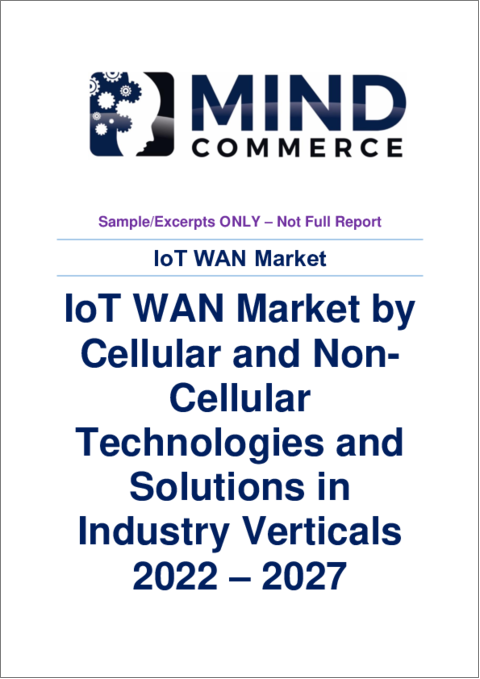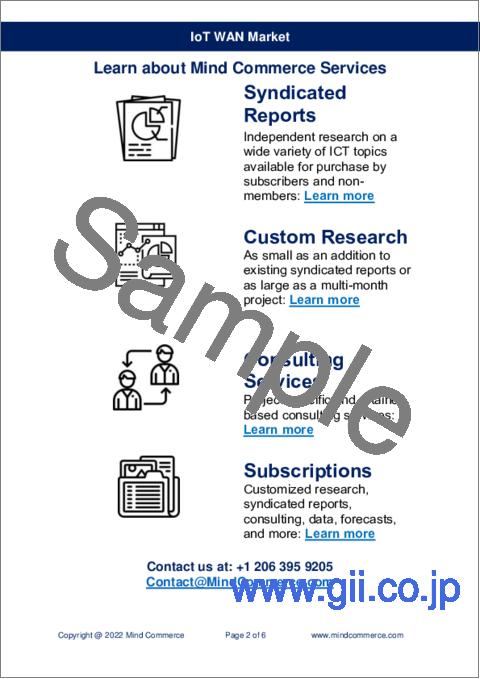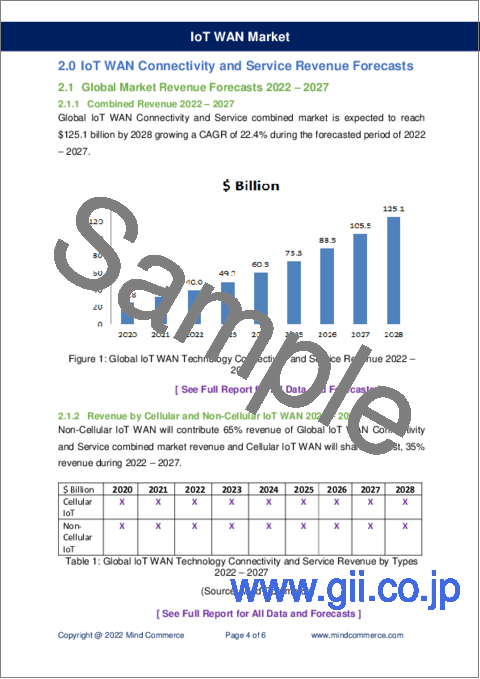|
|
市場調査レポート
商品コード
1174447
IoT WANの世界市場:セルラー系・非セルラー系技術とソリューション、業種別 (2022年~2027年)IoT WAN Market by Cellular and Non-Cellular Technologies and Solutions in Industry Verticals 2022 - 2027 |
||||||
| IoT WANの世界市場:セルラー系・非セルラー系技術とソリューション、業種別 (2022年~2027年) |
|
出版日: 2022年12月20日
発行: Mind Commerce
ページ情報: 英文 112 Pages
納期: 即日から翌営業日
|
- 全表示
- 概要
- 図表
- 目次
IoT (モノのインターネット) 向けのWAN通信は、急速に進化するIoTアプリケーションとサービスエコシステム向けのM2Mシグナリングの中核となるバックボーンです。セルラー方式のIoT WANは、EC-GSM-IoT/3GPP、LTE-M/3GPP、NB-IoT/3GPPの3方式が知られています。また、低ビットレートで長距離通信を可能にする非セルラー代替のLPWANアプローチもあります。これらの技術はそれぞれ、M2M/IoTのエコシステムにおいて重要な役割を担っています。
例えば、LPWANに接続されたセンサーは、ある物体と他の物体や環境との物理的・論理的関係の変化を検出するために使用されます。この種のソリューションは、さまざまな産業分野の多くの用途で使用されています。
民生用分野では、電子機器は歴史的に孤立して機能する物体として扱われてきました。しかし、ハイエンドの家電製品やデジタル機器・資産、そして多くの低価格のデバイスが、組み込みコンピューティングと通信によって接続性を獲得するにつれ、急速に変化しています。接続されたコンシューマー機器は、エンターテインメント、ニュース、情報、一般的なライフスタイルの向上など、さまざまな目的で使用される可能性があります。IoT WANは、コンシューマー機器、メーカー、サービスプロバイダー間のユビキタスM2M接続を実現する手段です。
IoTのエンドポイントやセキュリティ、電力などの関連問題に注目が集まっていますが、従来のM2Mから世界なIoTネットワークへの移行においては、ユビキタスな無線通信が依然として重要な課題となっています。IoT接続の採用は、LPWANネットワーク、ハードウェア、ソフトウェアサービスにとって大きな機会を創出します。
当レポートでは、世界のIoT WAN市場 (セルラー系・非セルラー系) について分析し、技術の概要やエコシステム、主な勝代事例、促進・抑制要因、ワイヤレスIoT WAN技術の特性と主な用途、将来的なIoT WAN技術の成長機会、全体的な市場規模の動向見通し (2022年~2027年)、などを調査しております。
目次
第1章 エグゼクティブサマリー
第2章 イントロダクション
- WAN (Wide Area Networks:広域ネットワーク)
- WANテクノロジー
- IoTのネットワークと活用領域
- ワイヤレスIoTとWAN
- IoT WANの標準化
- IoT WANの促進要因
- 通信プロトコル
- ネットワークのトポロジーと相互運用性
- インテリジェントIoTネットワーク
- M2M (machine-to-machine) 通信
- IoTに拡張されたホワイトボックスソリューション
- スマートシティへの取り組み
- LPWAN (低消費電力広域ネットワーク) の台頭
- IoT WANの課題
- セキュリティ上の問題
- 連続電源
第3章 ワイヤレスIoT WAN技術
- LPWANの代替案
- LPWANの特徴
- 航続距離とバッテリー寿命
- ノイズと帯域幅
- 無認可スペクトル
- 均一な帯域幅の欠如
- ローカリゼーション
- ネットワーク設定
- LPWANの最適化
- セルラーIoT
- 非セルラーIoT
- セルラー/非セルラーIoT WANの比較
- LPWANにおけるデータ圧縮の必要性
第4章 IoT WAN技術市場での機会
- IoT WANテクノロジーの必要性
- IoT WANテクノロジーの利点
- LoRa・LoRaWAN:急速に成長しているLPWANエコシステムの一部
- LoRa・LoRaWAN:世界中のパブリック IoTネットワークでの活用
- IoT WANテクノロジーに対する5Gの影響
第5章 非セルラー系組織
- LoRa Alliance
- SIGFOX
- Ingenu
- Nwave
- LinkLabs Symphony Link
- Weightless
- SemTech
- Senet
- Tata Communication
- IBM
- Cisco
- Huawei
- Ericsson
- Intel
- Nokia
- Greenvity
- Aclara
- Rajant
- セルラー系組織の選択
- British Telecom
- GSMA
- Vodafone
- Deutsche Telekom
- 3GPP
- Orange
- Proximus
- AT&T
- KPN
- Bouygues Telecom
- Du
- SK Telecom
第6章 LPWANの活用事例
- LPWANの活用状況
- 照明制御
- 駐車場管理
- セキュリティアクセス・制御
- スマートグリッド・需要応答 (DR)
- ロジスティクス・資産追跡
- 水道メーター・漏水検知
- スーパーマーケットと食品流通サプライチェーン
- 農業技術:灌漑管理など
- IoT WANの実装事例
- Kerlink・ClearBlade:スマートシティ・スマート農業向け資産追跡用のIoT-Edge LoRaWAN (R) ソリューションの提供
- コネクテッドシティ:アデレード
- グレータージーロング市:ケーススタディ
- Northumbrian Water:ケーススタディ
第7章 IoT WAN接続とサービス収益の予測
- 世界市場の収益予測 (2022年~2027年)
- 総収益 (2022年~2027年)
- IoT WANの収益:セルラー・非セルラー別 (2022年~2027年)
- 収益:業種別収益 (2022年~2027年)
- 地域市場の収益予測 (2022年~2027年)
- 収益:地域別 (2022年~2027年)
- 北米市場の収益 (2022年~2027年)
- アジア太平洋市場の収益 (2022年~2027年)
- 欧州市場の収益 (2022年~2027年)
- ラテンアメリカ市場の収益 (2022年~2027年)
- 中東・アフリカ市場の収益 (2022年~2027年)
第8章 IoT WAN接続デバイスの設置台数の予測 (2022年~2027年)
- 世界の展開台数の予測 (2022年~2027年)
- 設置台数:総数 (2022年~2027年)
- 設置台数:種類別 (2022年~2027年)
- 設置台数:用途別 (2022年~2027年)
- 地域別の設置台数の予測 (2022年~2027年)
- 設置台数:地域別 (2022年~2027年)
- 北米の設置台数 (2022年~2027年)
- アジア太平洋の設置台数 (2022年~2027年)
- 欧州の設置台数 (2022年~2027年)
- ラテンアメリカの設置台数 (2022年~2027年)
- 中東・アフリカの設置台数 (2022年~2027年)
第9章 結論・提言
Figures
- Figure 1: Wireless Network Standards for IoT
- Figure 2: Wireless IoT Wide Area Network Connectivity Ecosystem
- Figure 3: Wireless Network Standardization for IoT
- Figure 4: Wireless IoT Communication and Protocol Stack
- Figure 5: Star and Mesh Network Topology and Interconnection Pattern
- Figure 6: Intelligent IoT Network
- Figure 7: M2M Powered Air Traffic Control System with WAN
- Figure 8: Smart City Connectivity
- Figure 9: LPWAN Radios Range vs. Battery Life
- Figure 10: LPWAN Range vs. Bandwidth and Combination Point
- Figure 11: 3GPP IoT Proposals for LTE, Narrowband, and 5G Network
- Figure 12: LoRaWAN Network Architecture
- Figure 13: LPWAN Technology Comparison
- Figure 14: Cellular vs. Non-Cellular IoT WAN Comparison
- Figure 15: Intelligent Compression for LPWAN
- Figure 16: LoRaWAN Network Architecture
- Figure 17: LoRa LPWAN Network Connectivity Structure
- Figure 18: AT&T WAN Solution Architecture
- Figure 19: Cellular IoT Network Standard, Data Rates, and Sample Use Cases
- Figure 20: Cellular IoT Use Cases and Specific Requirements
- Figure 21: Global IoT WAN Technology Connectivity and Service Revenue 2022 - 2027
- Figure 22: Global IoT WAN Connected Device Deployment Unit 2022 - 2027
Tables
- Table 1: Data Compression and Savings for LPWAN
- Table 2: Global IoT WAN Technology Connectivity and Service Revenue by Types 2022 - 2027
- Table 3: Global Cellular IoT WAN Connectivity and Service Revenue by Category 2022 - 2027
- Table 4: Global Cellular IoT WAN Connectivity and Service Revenue by Network Type 2022 - 2027
- Table 5: Global Non-Cellular IoT WAN Connectivity and Service Revenue by Category 2022 - 2027
- Table 6: Global IoT WAN Connectivity and Service Revenue by Industry Vertical 2022 - 2027
- Table 7: Global Cellular IoT WAN Connectivity and Service Revenue by Industry Vertical 2022 - 2027
- Table 8: Global Non-Cellular IoT WAN Connectivity and Service Rev by Industry Vertical 2022 - 2027
- Table 9: IoT WAN Connectivity and Service Revenue by Region 2022 - 2027
- Table 10: Cellular IoT WAN Connectivity and Service Revenue by Region 2022 - 2027
- Table 11: Non-Cellular IoT WAN Connectivity and Service Revenue by Region 2022 - 2027
- Table 12: North America IoT WAN Connectivity and Service Revenue by Types 2022 - 2027
- Table 13: North America Cellular IoT WAN Connectivity and Service Revenue by Network Type 2022 - 2027
- Table 14: North America IoT WAN Connectivity and Service Revenue by Industry Vertical 2022 - 2027
- Table 15: APAC IoT WAN Connectivity and Service Revenue by Type 2022 - 2027
- Table 16: APAC Cellular IoT WAN Connectivity and Service Revenue by Network Type 2022 - 2027
- Table 17: APAC IoT WAN Connectivity and Service Revenue by Industry Vertical 2022 - 2027
- Table 18: Europe IoT WAN Connectivity and Service Revenue by Type 2022 - 2027
- Table 19: Europe Cellular IoT WAN Connectivity and Service Revenue by Network Type 2022 - 2027
- Table 20: Europe IoT WAN Connectivity and Service Revenue by Industry Vertical 2022 - 2027
- Table 21: Latin America IoT WAN Connectivity and Service Revenue by Type 2022 - 2027
- Table 22: Latin America Cellular IoT WAN Connectivity and Service Revenue by Network Type 2022 - 2027
- Table 23: Latin America IoT WAN Connectivity and Service Revenue by Industry Vertical 2022 - 2027
- Table 24: MEA IoT WAN Connectivity and Service Revenue by Type 2022 - 2027
- Table 25: MEA Cellular IoT WAN Connectivity and Service Revenue by Network Type 2022 - 2027
- Table 26: MEA IoT WAN Connectivity and Service Revenue by Industry Vertical 2022 - 2027
- Table 27: Global IoT WAN Connected Device Deployment by Type 2022 - 2027
- Table 28: Global Cellular IoT WAN Connected Device Deployment by Category 2022 - 2027
- Table 29: Global Non-Cellular IoT WAN Connected Device Deployment by Category 2022 - 2027
- Table 30: Global IoT WAN Connected Device Deployment by Vertical 2022 - 2027
- Table 31: Global Cellular IoT WAN Connected Device Deployment by Vertical 2022 - 2027
- Table 32: Global Non-Cellular IoT WAN Connected Device Deployment by Vertical 2022 - 2027
- Table 33: IoT WAN Connected Device Deployment by Region 2022 - 2027
- Table 34: Cellular IoT WAN Connected Device Deployment by Region 2022 - 2027
- Table 35: Non-Cellular IoT WAN Connected Device Deployment by Region 2022 - 2027
- Table 36: North America IoT WAN Connected Device Deployment by Type 2022 - 2027
- Table 37: North America IoT WAN Connected Device Deployment by Industry Vertical 2022 - 2027
- Table 38: APAC IoT WAN Connected Device Deployment by Type 2022 - 2027
- Table 39: APAC IoT WAN Connected Device Deployment by Industry Vertical 2022 - 2027
- Table 40: Europe IoT WAN Connected Device Deployment by Type 2022 - 2027
- Table 41: Europe IoT WAN Connected Device Deployment by Industry Vertical 2022 - 2027
- Table 42: Latin America IoT WAN Connected Device Deployment by Type 2022 - 2027
- Table 43: Latin America IoT WAN Connected Device Deployment by Industry Vertical 2022 - 2027
- Table 44: Middle East and Africa IoT WAN Connected Device Deployment by Type 2022 - 2027
- Table 45: MEA IoT WAN Connected Device Deployment by Industry Vertical 2022 - 2027
Overview:
This report evaluates IoT WAN technologies, companies, and solutions. The report assesses developments in the IoT WAN ecosystem, analyzes use cases, and provides a view into the future of IoT WAN communications. The report includes detailed forecasts for cellular and non-cellular IoT WANs 2022 to 2027.
Questions Answered in Report:
- Who are the cellular and non-cellular solution providers for IoT WAN?
- Who are the key players within the wireless IoT WAN ecosystem and why?
- How does the IoT WAN ecosystem accelerate IoT adoption of certain applications?
- What is the predominant technology for wireless IoT WAN and how does it support apps?
- Why Low-Power Wide Area Network (LPWAN) is considered the key technology for wireless IoT WAN?
Wide Area Network (WAN) communications for the Internet of Things (IoT) is the core backbone for machine-to-machine (M2M) signaling for the rapid-evolving IoT application and service ecosystem. The three cellular IoT WAN methods are known as EC-GSM-IoT/3GPP, LTE-M/3GPP, and NB-IoT/3GPP. There are also non-cellular alternative Low Power WAN (LPWAN) approaches that allow for long-range communications at a low bit rate. Each of these technologies have an important role to play in the M2M/IoT ecosystem.
For example, LPWAN connected sensors are used for the detection of changes in the physical and/or logical relationship of one object to another(s) and/or the environment. Physical changes may include temperature, light, pressure, sound, and motion. Logical changes include the presence/absence of an electronically traceable entity, location, and/or activity. Within an IoT context, physical and logical changes are equally important. These types of solutions are used for many industrial applications across a wide variety of industry verticals.
Within the consumer segment, electronic devices have historically represented stand-alone objects functioning in isolation. This is rapidly changing as high-end consumer appliances, digital equipment, and assets as well as many lower-cost devices gain connectivity through embedded computing and communications. A connected consumer device may be used for various purposes including entertainment, news, information, and general lifestyle enhancement. IoT WANs provide the means for ubiquitous M2M connectivity between consumer devices, manufacturers, and service providers.
While much focus is on IoT end-points and related issues such as security and power, ubiquitous wireless coverage remains the overarching issue for transformation from traditional M2M to global IoT networks. Adoption of IoT connectivity creates substantial opportunities for LPWAN network, hardware, and software services.
Companies in Report:
|
|
Table of Contents
1.0. Executive Summary
2.0. Introduction
- 2.1. Wide Area Networks
- 2.2. WAN Technologies
- 2.3. IoT Networks and Applications
- 2.4. Wireless IoT and WAN
- 2.5. IoT WAN Standardization
- 2.6. IoT WAN Growth Drivers
- 2.6.1. Communications Protocols
- 2.6.2. Network Topology and Interoperability
- 2.6.3. Intelligent IoT Network
- 2.6.4. M2M Communications
- 2.6.5. White Box Solutions Extended to IoT
- 2.6.6. Smart City Initiatives
- 2.6.7. The Rise of Low Power Wide Area Networks
- 2.7. IoT WAN Challenges
- 2.7.1. Security Issues
- 2.7.2. Continuous Power Supply
3.0. Wireless IoT WAN Technologies
- 3.1. Low Power Wide Area Networks Alternatives
- 3.2. LPWAN Characteristics
- 3.2.1. Range vs. Battery Life
- 3.2.2. Noise vs. Bandwidth
- 3.2.3. Unlicensed Spectrum
- 3.2.4. No Uniform Bandwidth
- 3.2.5. Localization
- 3.2.6. Network Configuration
- 3.2.7. LPWAN Optimization
- 3.3. Cellular IoT
- 3.4. Non-Cellular IoT
- 3.5. Cellular vs. Non-Cellular IoT WAN Comparison
- 3.6. Need for Data Compression in LPWAN
4.0. Opportunities with IoT WAN Technology Market
- 4.1. Need of IoT WAN Technology
- 4.2. Benefits of IoT WAN Technology
- 4.3. LoRa and LoRaWAN are part of the fast growing LPWAN Ecosystem
- 4.4. LoRa and LoRaWAN used in public IoT networks across the globe
- 4.5. Impact of 5G on IoT WAN Technology
5.0. Non-Cellular Organizations
- 5.1.1. LoRa Alliance
- 5.1.1.1. Company Background
- 5.1.1.2. Product Portfolio
- 5.1.1.3. Recent Development
- 5.1.2. SIGFOX
- 5.1.2.1. Company Background
- 5.1.2.2. Product Portfolio
- 5.1.2.3. Recent Developments
- 5.1.3. Ingenu
- 5.1.3.1. Company Background
- 5.1.3.2. Product Portfolio
- 5.1.3.3. Recent Developments
- 5.1.4. Nwave
- 5.1.4.1. Company Background
- 5.1.4.2. Product Portfolio
- 5.1.4.3. Recent Developments
- 5.1.5. LinkLabs Symphony Link
- 5.1.5.1. Company Background
- 5.1.5.2. Product Portfolio
- 5.1.5.3. Recent Developments
- 5.1.6. Weightless
- 5.1.6.1. Company Background
- 5.1.6.2. Product Portfolio
- 5.1.6.3. Recent Developments
- 5.1.7. SemTech
- 5.1.7.1. Company Background
- 5.1.7.2. Product Portfolio
- 5.1.7.3. Recent Developments
- 5.1.8. Senet
- 5.1.8.1. Company Background
- 5.1.8.2. Product Portfolio
- 5.1.8.3. Recent Developments
- 5.1.9. Tata Communication
- 5.1.9.1. Company Background
- 5.1.9.2. Product Portfolio
- 5.1.9.3. Recent Developments
- 5.1.10. IBM
- 5.1.10.1. Company Background
- 5.1.10.2. Product Portfolio
- 5.1.10.3. Recent Developments
- 5.1.11. Cisco
- 5.1.11.1. Company Background
- 5.1.11.2. Product Portfolio
- 5.1.11.3. Recent Developments
- 5.1.12. Huawei
- 5.1.12.1. Company Background
- 5.1.12.2. Product Portfolio
- 5.1.12.3. Recent Developments
- 5.1.13. Ericsson
- 5.1.13.1. Company Background
- 5.1.13.2. Product Portfolio
- 5.1.13.3. Recent Developments
- 5.1.14. Intel
- 5.1.14.1. Company Background
- 5.1.14.2. Product Portfolio
- 5.1.14.3. Recent Developments
- 5.1.15. Nokia
- 5.1.15.1. Company Background
- 5.1.15.2. Product Portfolio
- 5.1.15.3. Recent Developments
- 5.1.16. Greenvity
- 5.1.16.1. Company Background
- 5.1.16.2. Product Portfolio
- 5.1.16.3. Recent Developments
- 5.1.17. Aclara
- 5.1.17.1. Company Background
- 5.1.17.2. Product Portfolio
- 5.1.17.3. Recent Developments
- 5.1.18. Rajant
- 5.1.18.1. Company Background
- 5.1.18.2. Product Portfolio
- 5.1.18.3. Recent Developments
- 5.2. Select Cellular Organizations
- 5.2.1. British Telecom
- 5.2.1.1. Company Background
- 5.2.1.2. Recent Developments
- 5.2.2. GSMA
- 5.2.2.1. Company Background
- 5.2.2.2. Recent Developments
- 5.2.3. Vodafone
- 5.2.3.1. Company Background
- 5.2.3.2. Recent Developments
- 5.2.4. Deutsche Telekom
- 5.2.4.1. Company Background
- 5.2.4.2. Recent Developments
- 5.2.5. 3GPP
- 5.2.5.1. Company Background
- 5.2.5.2. Recent Developments
- 5.2.6. Orange
- 5.2.6.1. Company Background
- 5.2.6.2. Recent Developments
- 5.2.7. Proximus
- 5.2.7.1. Company Background
- 5.2.7.2. Recent Developments
- 5.2.8. AT&T
- 5.2.8.1. Company Background
- 5.2.8.2. Recent Developments
- 5.2.9. KPN
- 5.2.9.1. Company Background
- 5.2.9.2. Recent Developments
- 5.2.10. Bouygues Telecom
- 5.2.10.1. Company Background
- 5.2.10.2. Recent Development
- 5.2.11. Du
- 5.2.11.1. Company Background
- 5.2.11.2. Recent Developments
- 5.2.12. SK Telecom
- 5.2.12.1. Company Background
- 5.2.12.2. Recent Developments
6.0. LPWAN Use Cases
- 6.1. LPWAN Application Landscape
- 6.1.1. Lighting Control
- 6.1.2. Parking Management
- 6.1.3. Security Access and Control
- 6.1.4. Smart Grid and Demand Response
- 6.1.5. Logistics and Asset Tracking
- 6.1.6. Water Metering and Leak Detection
- 6.1.7. Supermarkets and Food Distribution Supply Chains
- 6.1.8. Agriculture Technology: Irrigation Management and More
- 6.2. IoT WAN Implementation Examples
- 6.2.1. Kerlink and ClearBlade Offering IoT-Edge LoRaWAN® Solution for Smart-City, Smart-Agriculture Asset Tracking
- 6.2.2. Connected Cities Adelaide
- 6.2.3. City of Greater Geelong Case Study
- 6.2.4. Northumbrian Water Case Study
7.0. IoT WAN Connectivity and Service Revenue Forecasts
- 7.1. Global Market Revenue Forecasts 2022-2027
- 7.1.1. Combined Revenue 2022-2027
- 7.1.2. Revenue by Cellular and Non-Cellular IoT WAN 2022-2027
- 7.1.2.1. Cellular IoT WAN Revenue by Category 2022-2027
- 7.1.2.2. Non-Cellular IoT WAN Revenue by Category 2022-2027
- 7.1.3. Revenue by Industry Vertical 2022-2027
- 7.1.3.1. Cellular IoT Revenue by Industry Vertical 2022-2027
- 7.1.3.2. Non-Cellular IoT Revenue by Industry Vertical 2022-2027
- 7.2. Regional Market Revenue Forecasts 2022-2027
- 7.2.1. Revenue by Region 2022-2027
- 7.2.1.1. Cellular IoT WAN Revenue by Region 2022-2027
- 7.2.1.2. Non-Cellular IoT WAN Revenue by Region 2022-2027
- 7.2.2. North America Market Revenue 2022-2027
- 7.2.2.1. Revenue by Type 2022-2027
- 7.2.2.2. Revenue by Industry Vertical 2022-2027
- 7.2.3. APAC Market Revenue 2022-2027
- 7.2.3.1. Revenue by Type 2022-2027
- 7.2.3.2. Revenue by Industry Vertical 2022-2027
- 7.2.4. Europe Market Revenue 2022-2027
- 7.2.4.1. Revenue by Type 2022-2027
- 7.2.4.2. Revenue by Industry Vertical 2022-2027
- 7.2.5. Latin America Market Revenue 2022-2027
- 7.2.5.1. Revenue by Type 2022-2027
- 7.2.5.2. Revenue by Industry Vertical 2022-2027
- 7.2.6. Middle East and Africa Market Revenue 2022-2027
- 7.2.6.1. Revenue by Type 2022-2027
- 7.2.6.2. Revenue by Industry Vertical 2022-2027
- 7.2.1. Revenue by Region 2022-2027
8.0. IoT WAN Connected Device Deployment Forecasts 2022-2027
- 8.1. Global Deployment Unit Forecasts 2022-2027
- 8.1.1. Combined Deployment Units 2022-2027
- 8.1.2. Deployment Units by Type 2022-2027
- 8.1.2.1. Cellular IoT WAN Deployment Unit by Category 2022-2027
- 8.1.2.2. Non-Cellular IoT WAN Deployment Unit by Category 2022-2027
- 8.1.3. Deployment Units by Industry Vertical 2022-2027
- 8.1.3.1. Cellular IoT WAN Deployment Unit by Industry Vertical 2022-2027
- 8.1.3.2. Non-Cellular IoT WAN Deployment Unit by Industry Vertical 2022-2027
- 8.2. Regional Deployment Unit Forecasts 2022-2027
- 8.2.1. Deployment Units by Region 2022-2027
- 8.2.1.1. Cellular IoT WAN Deployment Unit by Region 2022-2027
- 8.2.1.2. Non-Cellular IoT WAN Deployment Unit by Region 2022-2027
- 8.2.2. North America Deployment Units 2022-2027
- 8.2.2.1. Deployment Units by Type 2022-2027
- 8.2.2.2. Deployment Units by Industry Vertical 2022-2027
- 8.2.3. APAC Deployment Units 2022-2027
- 8.2.3.1. Deployment Units by Type 2022-2027
- 8.2.3.2. Deployment Units by Industry Vertical 2022-2027
- 8.2.4. Europe Deployment Units 2022-2027
- 8.2.4.1. Deployment Units by Type 2022-2027
- 8.2.4.2. Deployment Units by Industry Vertical 2022-2027
- 8.2.5. Latin America Deployment Units 2022-2027
- 8.2.5.1. Deployment Units by Type 2022-2027
- 8.2.5.2. Deployment Units by Industry Vertical 2022-2027
- 8.2.6. Middle East and Africa Deployment Units 2022-2027
- 8.2.6.1. Deployment Units by Type 2022-2027
- 8.2.6.2. Deployment Units by Industry Vertical 2022-2027
- 8.2.1. Deployment Units by Region 2022-2027
9.0. Conclusions and Recommendations
- 9.1. IoT WAN Evolution and Roadmap
- 9.2. Mobile Network Operator IoT WAN Strategies
- 9.3. Enterprise IoT WAN Strategies
- 9.4. Public Access LPWAN




